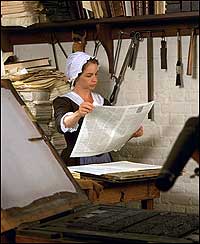Page content
 Clementina Rind (interpreted by Abigail Schumann) became publisher of the Virginia Gazette following the death of her husband William Rind. Clementina Rind (interpreted by Abigail Schumann) became publisher of the Virginia Gazette following the death of her husband William Rind.Click to enlarge |
Gentlewomen of the Press
By Jim BreigThat women were sometimes prominent in eighteenth-century journalism may be surprising today. It wasn't then. Journalism instructor Julie K. Williams of Samford University in Alabama said, "I have been very impressed that women had many roles in journalism and yet this was not considered extraordinary. There were a number of women printers, others who worked 'at case' as compositors and doubtless others in other capacities."
Williams cited Elizabeth Timothy, who assumed editorship of The South-Carolina Gazette in Charleston when her husband Lewis died in 1738, "making her the first woman editor in America. This was not hailed as a breakthrough or exciting; it was just another thing in the course of doing business. I find that very impressive. Working women were neither scoffed at nor admired. It was just normal for them to have a job."
Timothy was pregnant when she took over the newspaper and "had the baby, her seventh, about six weeks later without missing an issue of the paper," Williams said.
Cornelia Bradford took charge of The American Weekly Mercury in Philadelphia when her husband died, and John Peter Zenger's wife succeeded him upon his death in 1746. Some scholars call her Anna; others refer to her as Catherine.
Williams has examined "the content of these female editors' papers to see what they wrote about women as a topic. Elizabeth Timothy instigated arguments between her male and female readers about the meaning of love and marriage. She ran an article suggesting bachelors should be fined. She also ran an article advising women on whom to date—only men of courage.
"Cornelia Bradford scoffed at silly women who followed the celebrity evangelist George Whitfield and gave him money. I think she saw them as weak-minded celebrity-chasers.
"Catherine Zenger published the case—one author says it was fictitious—of a woman hauled into court for giving birth to yet another bastard child, when the father was one of the judges on that circuit. He was shamed into marrying her. Catherine also ran an article indignant about a man who abused his baby daughter until she died, because he would rather have had a son. She was angry because the jury let him off with a verdict of manslaughter; she clearly thought this was an atrocity."
Among the other women-editors of the eighteenth century were Mary Katherine Goddard of Baltimore, the first printer to include a list of all the signers when she published the Declaration of Independence in 1777; Clementina Rind, who operated the Virginia Gazette in Williamsburg after her husband William died; Louisa Susanna Wells, whose father, Robert, ran the South Carolina and American General Gazette in Charleston; and Anne Green, who headed the Maryland Gazette after her husband Jonas died in 1767.
Learn more:
